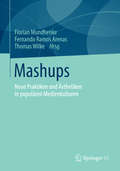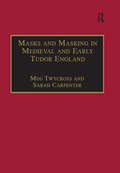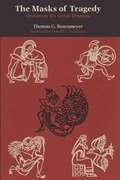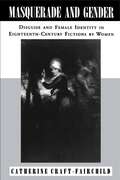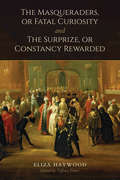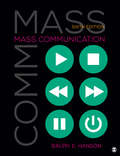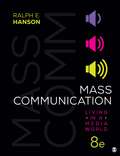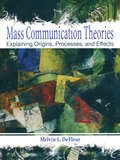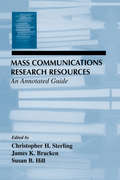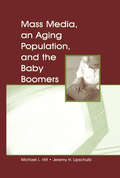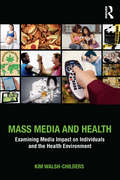- Table View
- List View
Masculinity in Transition
by K. Allison HammerLocating the roots of toxic masculinity and finding its displacement in unruly culture Masculinity in Transition analyzes shifting relationships to masculinity in canonical works of twentieth-century literature and film, as well as in twenty-first-century media, performance, and transgender poetics. Focusing on &“toxic masculinity,&” which has assumed new valence since 2016, K. Allison Hammer traces its roots to a complex set of ideologies embedded in the histories of settler colonialism, racial capitalism, and political fraternity, and finds that while toxic strains of masculinity are mainly associated with straight, white men, trans and queer masculinities can be implicated in these systems of power. Hammer argues, however, that these malignant forms of masculinity are not fixed and can be displaced by &“unruly alliances&”—texts and relationships that reject the nationalisms and gender politics of white male hegemony and perform an urgently needed reimagining of what it means to be masculine. Locating these unruly alliances in the writings, performances, and films of butch lesbians, gay men, cisgender femmes, and trans and nonbinary individuals, Masculinity in Transition works through an archive of works of performance art, trans poetics, Western films and streaming media, global creative responses to HIV/AIDS, and working-class and &“white trash&” fictions about labor and unionization. Masculinity in Transition moves the study of masculinity away from an overriding preoccupation with cisnormativity, whiteness, and heteronormativity, and toward a wider and more generative range of embodiments, identifications, and ideologies. Hammer&’s bold rethinking of masculinity and its potentially toxic effects lays bare the underlying fragility of normative masculinity. Retail e-book files for this title are screen-reader friendly with images accompanied by short alt text and/or extended descriptions.
Mashups
by Florian Mundhenke Fernando Ramos Arenas Thomas WilkeMashup hat sich als Begriff eingebürgert für auditiv, visuell, audiovisuell ,,vermischte" Neuarrangements, Collagen, Bricolagen in der Musik, in Videos, in Computerspielen, in der (aktuellen Medien-)Kunst, in der Architektur. Es handelt sich um eine Verbindung heterogener Elemente, die etwas (scheinbar) Neues hervorbringen. Im Internet verbinden Websites unterschiedliche Elemente (beispielsweise Musik, Video, Hyperlinks) mit unterschiedlichen Funktionen. Ausgangspunkt für diesen Band ist die These, dass es einerseits mediale und kulturelle Techniken gibt, die diese Form des Mischgenres erst ermöglichen. Andererseits muss berücksichtigt werden, dass die mediale Kompetenz der User exponentiell angestiegen ist und weiter ansteigt. Der Band geht unter anderem der Frage nach, inwieweit es sich bei Mashups um eine qualitativ neue Form der Aneignung und/oder nur eine produktive Auseinandersetzung mit medialen Angeboten handelt.
Masked
by Alfred HabeggerA brave British widow goes to Siam and-by dint of her principled and indomitable character-inspires that despotic nation to abolish slavery and absolute rule: this appealing legend first took shape after the Civil War when Anna Leonowens came to America from Bangkok and succeeded in becoming a celebrity author and lecturer. Three decades after her death, in the 1940s and 1950s, the story would be transformed into a powerful Western myth by Margaret Landon's best-selling book "Anna and the King of Siam" and Rodgers and Hammerstein's musical "The King and I. " But who was Leonowens and why did her story take hold? Although it has been known for some time that she was of Anglo-Indian parentage and that her tales about the Siamese court are unreliable, not until now, with the publication of "Masked," has there been a deeply researched account of her extraordinary life. Alfred Habegger, an award-winning biographer, draws on the archives of five continents and recent Thai-language scholarship to disclose the complex person behind the mask and the troubling facts behind the myth. He also ponders the curious fit between Leonowens's compelling fabrications and the New World's innocent dreams-in particular the dream that democracy can be spread through quick and easy interventions. Exploring the full historic complexity of what it once meant to pass as white, "Masked" pays close attention to Leonowens's midlevel origins in British India, her education at a Bombay charity school for Eurasian children, her material and social milieu in Australia and Singapore, the stresses she endured in Bangkok as a working widow, the latent melancholy that often afflicted her, the problematic aspects of her self-invention, and the welcome she found in America, where a circle of elite New England abolitionists who knew nothing about Southeast Asia gave her their uncritical support. Her embellished story would again capture America's imagination as World War II ended and a newly interventionist United States looked toward Asia. "
Masks and Masking in Medieval and Early Tudor England (Studies in Performance and Early Modern Drama)
by Meg Twycross Sarah CarpenterDrawing on broad research, this study explores the different social and theatrical masking activities in England during the Middle Ages and the early 16th century. The authors present a coherent explanation of the many functions of masking, emphasizing the important links among festive practice, specialized ceremonial, and drama. They elucidate the intellectual, moral and social contexts for masking, and they examine the purposes and rewards for participants in the activity. The authors' insight into the masking games and performances of England's medieval and early Tudor periods illuminates many aspects of the thinking and culture of the times: issues of identity and community; performance and role-play; conceptions of the psyche and of the individual's position in social and spiritual structures. Masks and Masking in Medieval and Early Tudor England presents a broad overview of masking practices, demonstrating how active and prominent an element of medieval and pre-modern culture masking was. It has obvious interest for drama and literature critics of the medieval and early modern periods; but is also useful for historians of culture, theatre and anthropology. Through its analysis of masked play this study engages both with the history of theatre and performance, and with broader cultural and historical questions of social organization, identity and the self, the performance of power, and shifting spiritual understanding.
Masks of Conquest: Literary Study and British Rule in India (The Social Foundations Of Aesthetic Forms)
by Gauri ViswanathanA classic work in postcolonial studies, Masks of Conquest describes the introduction of English studies in India under British rule and illuminates the discipline's transcontinental movements and derivations, showing that the origins of English studies are as diverse and diffuse as its future shape. In her new preface, Gauri Viswanathan argues forcefully that the curricular study of English can no longer be understood innocently of or inattentively to the imperial contexts in which the discipline first articulated its mission.
Masks of Conquest
by Gauri ViswanathanDescribes the introduction of English studies in India under British rule and its function as an effective form of political control
Masks of Conquest
by Gauri ViswanathanDescribes the introduction of English studies in India under British rule and its function as an effective form of political control
The Masks of Tragedy: Essays on Six Greek Dramas
by Thomas G. Rosenmeyer"What matters about a play is not the extent to which it is like any other play, but the way in which it is different," writes Thomas G. Rosenmeyer. "This is, I suggest, how the ancient audiences received the performances. . . . My purpose, then, in writing these essays is twofold: . . . to devote enough space to the discussion of each play to allow its special tone and texture to emerge without hindrance and at leisure . . . and to include in one collection analyses of plays so different from one another that the accent will come to rest on the variety of the tragic experience rather than on any one narrowly defined norm. " Greek tragedy is a vehicle for many different ideas and many different intentions. From the wealth of material that has come down to us the author has chosen six plays for analysis. He reminds us that the plays were written to be seen and heard, and only secondarily to be studied. The listeners expected each play to have a specific objective, and to exhibit its own mood. These the author attempts to recover for us, by listening to what each play, in its own right, has to say. His principal concern is with the tragic diction and the tragic ideas, designed to release certain massive responses in the large theater-going group of ancient Athens. In exploring the characters and the situations of the plays he has chosen, the author transports his reader to the world of fifth-century B. C. Greece, and establishes the relevance of that world to our own experience. The essays are not introductory in nature. No space is given, for instance, to basic information about the playwrights, the history of Greek drama, or the special features of the Attic stage. Yet the book addresses itself to classicists and nonclassicists alike. The outgrowth of a series of lectures to nonspecialists, its particular appeal is to students of literature and the history of Western thought. Parallels are drawn between the writings of the philosophers and the tragedies, and attention is paid to certain popular Greek beliefs that colored the tragic formulations. Ultimately, however, the approach is not historical but critical; it is the author''s intention to demonstrate the beauty and the craftsmanship of the plays under discussion. "What matters about a play is not the extent to which it is like any other play, but the way in which it is different," writes Thomas G. Rosenmeyer. "This is, I suggest, how the ancient audiences received the performances. . . . My purpose, then, in writing these essays is twofold: . . . to devote enough space to the discussion of each play to allow its special tone and texture to emerge without hindrance and at leisure . . . and to include in one collection analyses of plays so different from one another that the accent will come to rest on the variety of the tragic experience rather than on any one narrowly defined norm. " Greek tragedy is a vehicle for many different ideas and many different intentions. From the wealth of material that has come down to us the author has chosen six plays for analysis. He reminds us that the plays were written to be seen and heard, and only secondarily to be studied. The listeners expected each play to have a specific objective, and to exhibit its own mood. These the author attempts to recover for us, by listening to what each play, in its own right, has to say. His principal concern is with the tragic diction and the tragic ideas, designed to release certain massive responses in the large theater-going group of ancient Athens. In exploring the characters and the situations of the plays he has chosen, the author transports his reader to the world of fifth-century B. C. Greece, and establishes the relevance of that world to our own experience. The essays are not introductory in nature. No space is given, for instance, to basic information about the playwrights, the history of Greek drama, or the special features of the Attic stage. Yet the book addresses itself to classicists and nonclassicists alike. The outgrowth of a series of lecture...
Masquerade and Gender: Disguise and Female Identity in Eighteenth-Century Fictions by Women (G - Reference, Information and Interdisciplinary Subjects)
by Catherine A. Craft-FairchildTerry Castle's recent study of masquerade follows Bakhtin's analysis of the carnivalesque to conclude that, for women, masquerade offered exciting possibilities for social and sexual freedom. Castle's interpretation conforms to the fears expressed by male writers during the period—Addison, Steele, and Fielding all insisted that masquerade allowed women to usurp the privileges of men. Female authors, however, often mistrusted these claims, perceiving that masquerade's apparent freedoms were frequently nothing more than sophisticated forms of oppression. Catherine Craft-Fairchild's work provides a useful corrective to Castle's treatment of masquerade. She argues that, in fictions by Aphra Behn, Mary Davys, Eliza Haywood, Elizabeth Inchbald, and Frances Burney, masquerade is double-sided. It is represented in some cases as a disempowering capitulation to patriarchal strictures that posit female subordination. Often within the same text, however, masquerade is also depicted as an empowering defiance of the dominant norms for female behavior. Heroines who attempt to separate themselves from the image of womanhood they consciously construct escape victimization. In both cases, masquerade is the condition of femininity: gender in the woman's novel is constructed rather than essential.Craft-Fairchild examines the guises in which womanhood appears, analyzing the ways in which women writers both construct and deconstruct eighteenth-century cultural conceptions of femininity. She offers a careful and engaging textual analysis of both canonical and noncanonical eighteenth-century texts, thereby setting lesser-read fictions into a critical dialogue with more widely known novels. Detailed readings are informed throughout by the ideas of current feminist theorists, including Luce Irigaray, Julia Kristeva, Mary Ann Doane, and Kaja Silverman. Instead of assuming that fictions about women were based on biological fact, Craft-Fairchild stresses the opposite: the domestic novel itself constructs the domestic woman.
The Masqueraders, or Fatal Curiosity, and The Surprize, or Constancy Rewarded
by Eliza Haywood Tiffany PotterThe most important female English novelist of the 1720s, Eliza Haywood is famous for writing scandalous fiction about London society. Fast-moving, controversial, and sometimes disturbing, Haywood's short novels The Masqueraders and The Surprize are valuable sources for the study of eighteenth-century gender and identity, the social history of masquerade, the dangers of courtship and seduction, and conceptions of elite and popular cultures.Despite their common theme of masquerade and seduction, the two short novels are a study in contrasts. The Masqueraders features the whirl of London life, with a libertine anti-hero and his serial seductions of women who believe that they can manipulate the social conventions that are expected to limit them. The Surprize, on the other hand, is an uncharacteristically sentimental story in which a similarly salacious plot ends in rewards for the good and virtuous.Well suited to the teaching of these two texts, this volume contains annotated scholarly editions of both novels, an extensive introduction, and useful appendices that discuss the masquerade's role in eighteenth-century debates on gender, morality, and identity.
The Mass Audience: Rediscovering the Dominant Model (Routledge Communication Series)
by James Webster Patricia F. PhalenIn the early 20th century, a new and distinctive concept of the audience rose to prominence. The audience was seen as a mass -- a large collection of people mostly unknown to one another -- that was unified through exposure to media. This construct offered a pragmatic way to map audiences that was relevant to industry, government, and social theorists. In a relatively short period of time, it became the dominant model for studying the audience. Today, it is so pervasive that most people simply take it for granted. Recently, media scholars have reopened inquiry into the meaning of "audience." They question the utility of the mass audience concept, characterizing it as insensitive to differences among audience members inescapably bound up with discredited notions of mass society, or serving only a narrow set of industrial interests. The authors of this volume find that these assertions are often false and unwarranted either by the historical record or by contemporary industry practice. Instead, they argue for a rediscovery of the dominant model by summarizing and critiquing the very considerable body of literature on audience behavior, and by demonstrating different ways of analyzing mass audiences. Further, they provide a framework for understanding the future of the audience in the new media environment, and suggest how the concept of mass audience can illuminate research on media effects, cultural studies, and media policy.
Mass Communication: Living in a Media World
by Ralph E. HansonTransform your students into smart, savvy consumers of the media. Mass Communication: Living in a Media World (Ralph E. Hanson) provides students with comprehensive yet concise coverage of all aspects of mass media, along with insightful analysis, robust pedagogy, and fun, conversational writing. In every chapter of this bestselling text, students will explore the latest developments and current events that are rapidly changing the media landscape. This newly revised Sixth Edition is packed with contemporary examples, engaging infographics, and compelling stories about the ways mass media shape our lives. From start to finish, students will learn the media literacy principles and critical thinking skills they need to become savvy media consumers.
Mass Communication: Living in a Media World
by Ralph E. HansonTransform your students into smart, savvy consumers of the media. Mass Communication: Living in a Media World (Ralph E. Hanson) provides students with comprehensive yet concise coverage of all aspects of mass media, along with insightful analysis, robust pedagogy, and fun, conversational writing. In every chapter of this bestselling text, students will explore the latest developments and current events that are rapidly changing the media landscape. This newly revised Sixth Edition is packed with contemporary examples, engaging infographics, and compelling stories about the ways mass media shape our lives. From start to finish, students will learn the media literacy principles and critical thinking skills they need to become savvy media consumers.
Mass Communication: Living in a Media World
by Ralph E. HansonTransform your students into smart, savvy media consumers. A book that students find fun to read and instructors consider educationally valuable, Mass Communication: Living in a Media World provides the media literacy principles and critical thinking skills that students need to become self-aware media consumers. Known for his storytelling approach, bestselling author Ralph E. Hanson uses examples drawn from everyday life to explain the many dimensions of mass media that operate in our society. This newly revised Seventh Edition is packed with contemporary examples and compelling stories that illustrate the latest developments and recent events that are changing the face of media today.
Mass Communication: Living in a Media World
by Ralph E. HansonTransform your students into smart, savvy media consumers. A book that students find fun to read and instructors consider educationally valuable, Mass Communication: Living in a Media World provides the media literacy principles and critical thinking skills that students need to become self-aware media consumers. Known for his storytelling approach, bestselling author Ralph E. Hanson uses examples drawn from everyday life to explain the many dimensions of mass media that operate in our society. This newly revised Seventh Edition is packed with contemporary examples and compelling stories that illustrate the latest developments and recent events that are changing the face of media today.
Mass Communication: Living in a Media World
by Ralph E. HansonThe best-selling Mass Communication: Living in a Media World presents a highly accessible introduction to mass communication that equips students with the critical thinking skills to become savvy media consumers. To help students better retain the material, author Ralph E. Hanson uses a storytelling approach that weaves in examples drawn from everyday life. Readers are encouraged to consider the media industry from the inside out and, in doing so, discover the many dimensions of mass communication that operate in our society. The thoroughly revised Eighth Edition highlights how social and digital media, video games, and the COVID-19 pandemic are changing the face of media. This title is accompanied by a complete teaching and learning package.
Mass Communication: Living in a Media World
by Ralph HansonThe best-selling Mass Communication: Living in a Media World presents a highly accessible introduction to mass communication that equips students with the critical thinking skills to become savvy media consumers. To help students better retain the material, author Ralph E. Hanson uses a storytelling approach that weaves in examples drawn from everyday life. Readers are encouraged to consider the media industry from the inside out and, in doing so, discover the many dimensions of mass communication that operate in our society. The thoroughly revised Eighth Edition highlights how social and digital media, video games, and the COVID-19 pandemic are changing the face of media. This title is accompanied by a complete teaching and learning package.
Mass Communication: Living in a Media World
by Ralph E. HansonThe best-selling Mass Communication: Living in a Media World offers an accessible introduction to mass communication, equipping students with the critical thinking skills to become savvy media consumers. Using a storytelling approach, the text weaves in examples drawn from everyday life, making it easier for students to retain the material and connect it to their own media experiences. Readers are encouraged to consider the media industry from the inside out and, in doing so, discover the many dimensions of mass communication that operate in our society. This newly revised Ninth Edition highlights the aftermath of how the media industry and media consumers have evolved since the global pandemic, closely examining the changing the face of media today.
Mass Communication: Living in a Media World
by Ralph E. HansonThe best-selling Mass Communication: Living in a Media World offers an accessible introduction to mass communication, equipping students with the critical thinking skills to become savvy media consumers. Using a storytelling approach, the text weaves in examples drawn from everyday life, making it easier for students to retain the material and connect it to their own media experiences. Readers are encouraged to consider the media industry from the inside out and, in doing so, discover the many dimensions of mass communication that operate in our society. This newly revised Ninth Edition highlights the aftermath of how the media industry and media consumers have evolved since the global pandemic, closely examining the changing the face of media today.
Mass Communication In India: A Sociological Perspective
by J V VilanilamThis book traces the progress of mass communications in India and the West from a historical and sociological perspective, from primitive to modern times. Placing his argument in the global context within which mass communication takes place, the author: - Emphasizes the distinction between communication and mass communication—the former being a two-way exchange and the latter mostly a one-way communication. - Discusses the relevance of mass communication for the largely illiterate population of India, with particular reference to the type of media content and the inadequacy of conventional schooling. - Discusses the rapid technological progress in the world in recent decades in the context of digitalization, computerization and media convergence, as well as the global nature of mass communication. - Highlights that almost half the world`s population remains untouched by the communications revolution even at the beginning of the 21st century. - Examines the potential of EDUSAT, the educational satellite launched recently, as a means to bring education and information to all sectors of the Indian population.
Mass Communication Theories: Explaining Origins, Processes, and Effects
by Margaret H. DeFleur Melvin L. DeFleurMass Communication Theories: Explaining Origins, Processes, and Effects explores mass communication theories within the social and cultural context that influenced their origins. An intimate examination of the lives and times of prominent mass communication theorists both past and present bring the subject to life for the reader.
Mass Communications Research Resources: An Annotated Guide (Routledge Communication Series)
by Christopher H. Sterling Susan M. Hill James K. BrackenThis reference book is designed as a road map for researchers who need to find specific information about American mass communication as expeditiously as possible. Taking a topical approach, it integrates publications and organizations into subject-focused chapters for easy user reference. The editors define mass communication to include print journalism and electronic media and the processes by which they communicate messages to their audiences. Included are newspaper, magazine, radio, television, cable, and newer electronic media industries. Within that definition, this volume offers an indexed inventory of more than 1,400 resources on most aspects of American mass communication history, technology, economics, content, audience research, policy, and regulation. The material featured represents the carefully considered judgment of three experts -- two of them librarians -- plus four contributors from different industry venues. The primary focus is on the domestic American print and electronic media industries. Although there is no claim to a complete census of all materials on print journalism and electronic media -- what is available is now too vast for any single guide -- the most important and useful items are here. The emphasis is on material published since 1980, though useful older resources are included as well. Each chapter is designed to stand alone, providing the most important and useful resources of a primary nature -- organizations and documents as well as secondary books and reports. In addition, online resources and internet citations are included where possible.
Mass-Market Fiction and the Crisis of American Liberalism, 1972–2017
by Michael J. BlouinMass-Market Fiction and the Crisis of American Liberalism, 1972–2017 tracks the transformation of liberal thought in the contemporary United States through the unique lens of the popular paperback. The book focuses on cultural shifts as they appear in works written by some of the most widely-read authors of the last fifty years: the idea of love within a New Economy (Danielle Steel), the role of government in scientific inquiry (Michael Crichton), entangled political alliances and legacies in the aftermath of the 1960s (Tom Clancy), the restructured corporation (John Grisham), and the blurred line between state and personal empowerment (Dean Koontz). To address the current crisis, this book examines how the changed character of American liberalism has been rendered legible for a mass audience.
Mass Media, An Aging Population, and the Baby Boomers (Routledge Communication Series)
by Jeremy H. Lipschultz Michael L. HiltAs the oldest members of the baby boomer generation head into their retirement years, this demographic shift is having a substantial influence on uses of mass media, as well as the images portrayed in these media. Mass Media, An Aging Population, and the Baby Boomers provides a comprehensive examination of the relationship between media and aging issues, addressing mass media theory and practice as it relates to older Americans.Reviewing current research on communication and gerontology, authors Michael Hilt and Jeremy Lipschultz focus on aging baby boomers and their experiences with television, radio, print media, entertainment, advertising and public relations, along with the Internet and new media. They draw from studies about health and sexuality to understand views of aging, and present a view of older people as important players in the political process. Hilt and Lipschultz conclude the volume by addressing trends and making predictions related to baby boomers and mass media.Providing a timely and insightful examination of the linkage between mass media and aging issues, this volume will prove a valuable resource for scholars and students in media and gerontology. It is intended for use in coursework addressing such topics as mass communication and society, media and aging, media and public opinion, sociology, and social gerontology.
Mass Media and Health: Examining Media Impact on Individuals and the Health Environment
by Kim Walsh-ChildersMass Media and Health: Examining Media Impact on Individuals and the Health Environment covers media health influences from a variety of angles, including the impact on individual and public health, the intentionality of these effects, and the nature of the outcomes. Author Kim Walsh-Childers helps readers understand the influence that mass media has on an individual’s health beliefs and, in turn, their behaviors. She explains how public health policy can be affected, altering the environment in which a community’s members make choices, and discusses the unintentional health effects of mass media, examining them through the strategic lens of news framing and advocacy campaigns. Written for students across a variety of disciplines, Mass Media and Health will serve as primary reading for courses examining the broader view of mass media and health impacts, as well as providing supplemental reading for courses on health communication, public health campaigns, health journalism, and media effects.

